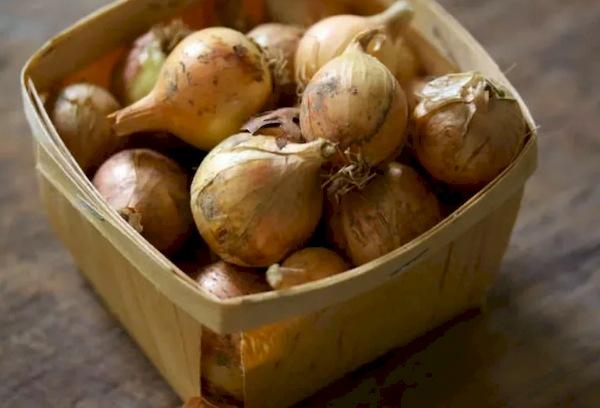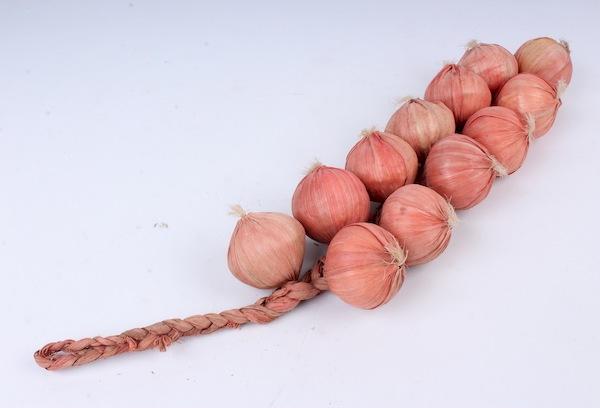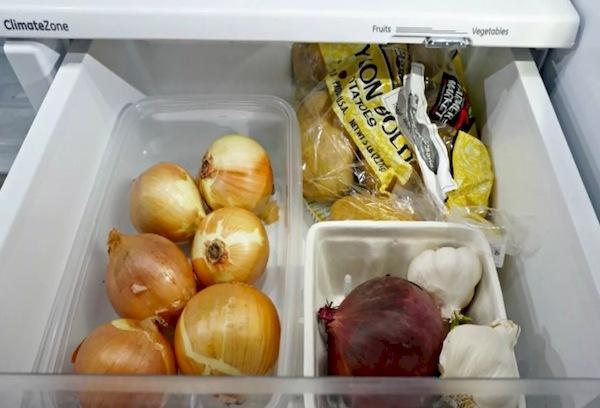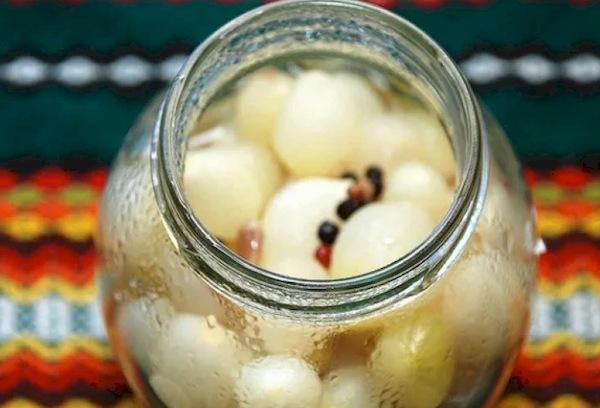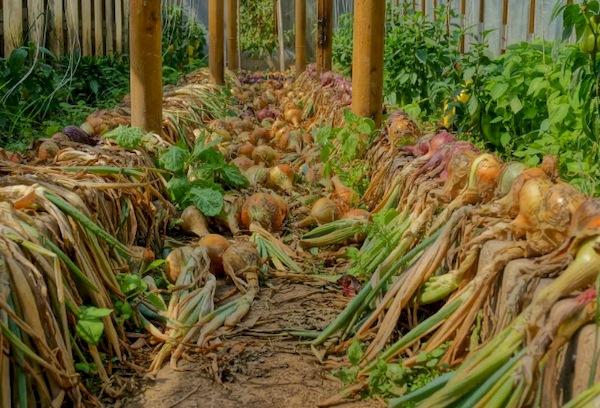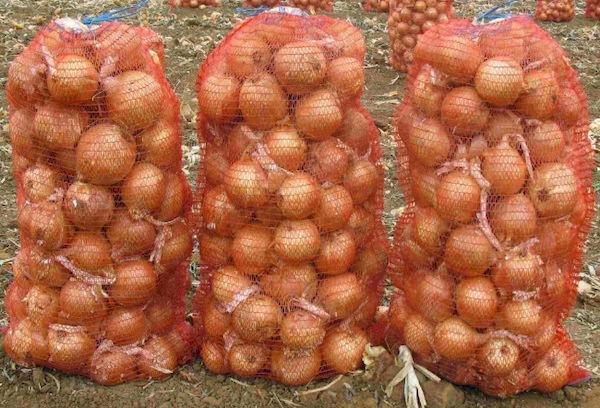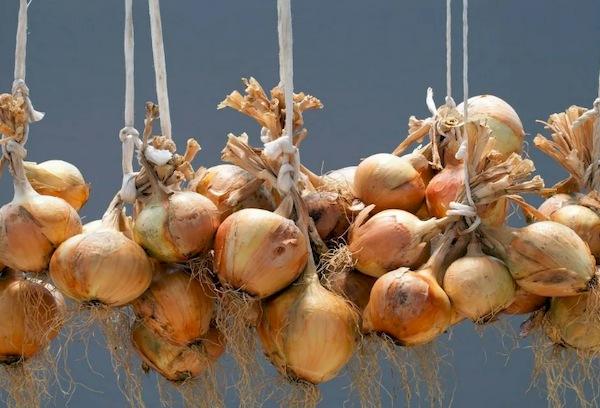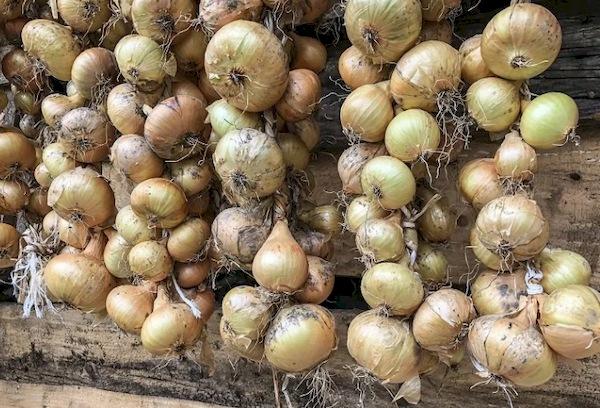Where and how to store onions in an apartment, is it safe to store them in the refrigerator?
Content:
The question of how to store onions arises mainly for summer residents who need to preserve their own harvest. Few people have special storage at their disposal; they have to look for a suitable place in the apartment. There are different ways to store turnips at home; you can choose several of them or use just one.
Preparing onions for storage
Preparation for winter storage begins with drying the onions well. Typically this process takes 2-2.5 weeks. Drying is carried out immediately after harvesting. The fact that the heads are sufficiently dried can be judged by the dried feather. The bulbs are then sorted. Medium sized heads are best stored.
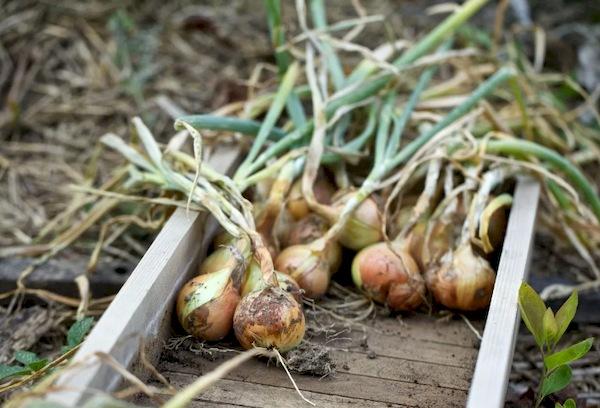
Small and large onions will need to be eaten first. For ease of storage, dry feathers are trimmed, but this should be done not at the root, but leaving stubs 4 cm high. The roots should also be trimmed, without injuring the bottom.
Burning the roots or lubricating them with a lime solution will help reduce the risk of onion sprouting. It is worth considering that onions processed using one of these methods will only be suitable for eating, but not for planting.After this, choose a method for storing the turnips. The onion can be placed in a container or braided and hung (in this case the feather is not cut off).
What is the best way to store onions?
Ideally, it is better to store onions in their natural shell, maintaining optimal temperature and humidity parameters. However, in practice, gardeners often encounter problems, for example, there is no suitable storage or the onions rot while still in the garden.
Once rot appears, drying will no longer help. If the onion rots, it is peeled, the scales affected by rot are removed and stored in this form. Of course, not just any method will work in this case. This onion can be pickled, dried or frozen. Severely damaged specimens should be thrown away.
Top 5 ways to store onions
Resourceful gardeners, forced to take care of preserving their harvest, have invented many options for storing onions. However, not all of them are universal and convenient for most. At the same time, there are methods that are accessible to everyone and therefore are popular.
On the balcony
Only a closed balcony is suitable for storing turnips, which maintains above-zero temperatures in autumn and winter. As long as the thermometer does not drop below + 10° C, onions can be stored:
- in open boxes;
- in cardboard boxes;
- in braids.
As winter approaches, you need to make sure that the vegetables on the balcony do not freeze. Long-term storage will be ensured if you place the turnip in an insulated box.
A box lined with foam is best suited for this purpose. The lid also needs to be insulated. In the most severe frosts, throw an old warm jacket or blanket on top of the box. Onions will keep well at zero temperatures and will withstand temperatures down to -3° C.Plastic containers are not suitable for this purpose, since plastic does not absorb excess moisture, unlike wood and cardboard.
Braiding
You can store onions in your apartment by braiding them. In this case, the turnip feather is not cut off, but drying is completed while the tops remain a little soft. This type of braid is also called a braid or braid. At temperatures up to + 15° C, onions can be stored in this way for quite a long time - several months.
Advantages of storage in a bundle:
- good air circulation is ensured, the onion is ventilated from all sides;
- convenient access to the heads to inspect them for damage;
- easier removal of rotten or moldy onions;
- inaccessibility of turnips to rodents;
- saving storage space.
To braid a braid you will need strong twine or thin rope. The twine is folded in half, thus obtaining two tails. The onion tops will act as the third tail.
Then everything happens in the same way as when weaving hair braids. With each subsequent overlap, another onion is woven into the braid. You can do it easier and just stuff the bulbs into old nylon stockings and then hang them up. The principle of storage in this case will be the same as in braids.
In the refrigerator or freezer
The refrigerator storage method is often used, but has two disadvantages. Only a small part of the crop can fit into the chamber. In addition, onions require lower humidity than that maintained in the refrigerator.
The unpeeled heads are placed in the vegetable compartment. Here the turnips can be stored in bulk or divided into portions and packaged in paper bags. In this way, the vegetable can be stored for 2 months.
You can store peeled onions by placing them in a glass jar or plastic container and filling them with cold water. Water needs to be changed every 2 days. The shelf life in this case is 20 days. Peeled and cut into pieces onions are stored in the refrigerator for a very short time - only a few days. In this case, it must be wrapped in cling film or packaged in a plastic container with a lid.
Storing turnips in the freezer is also acceptable, but you need to do it correctly:
- it is necessary to peel, wash and cut the vegetable into small cubes in advance;
- the slices are laid out on a tray in 1 layer and placed in the freezer for preliminary “setting”;
- then the onions are packaged in small portions, which can be used at a time during cooking;
- It is better to take plastic containers with lids or plastic bags with a zipper for storage.
Thawing and re-freezing of the product is not allowed. With this storage method, turnips can last in the freezer for 1 year.
Onion preservation
There is a classic method of preserving onions, which housewives have been using for years. This will require additional ingredients.
List of spices and seasonings per 1 kg of onion:
- 2 tbsp. l. granulated sugar;
- 1 tbsp. l. salt;
- 200 ml 9% vinegar;
- 2 pcs. bay leaf;
- 4-5 peas of allspice;
- 2-3 buds of cloves.
You will also need 1 liter of filtered or spring water. Peeled and washed medium-sized onions are placed in sterilized jars, poured with boiling water and left covered for 5-7 minutes.
Then the water is poured into a saucepan and the marinade is prepared with the addition of the listed spices. After the liquid boils, pour it over the onions. The jars are then sealed with sterilized lids.These onions are stored at home, for example, on a shelf in the pantry or in a closet.
The recipe can be modified to add additional flavor to the bulbs. For example, if you put several slices of raw beets in jars, you will get a bright purple onion with a beet flavor. In winter, canned onions sell like crazy.
The prepared vegetable has a delicate taste and is suitable as an addition to many dishes. If you preserve small onions in this way, they can be served as a snack with alcohol during a feast. Onions are tasty with the addition of spices, salt, tomato juice, sealed in jars.
Instead of canning the onions, you can marinate them and cut them into rings. Instead of table vinegar, it is permissible to add lemon juice or apple cider vinegar to the marinade; it is also a good idea to add parsley. Some housewives prepare fried onions by pouring vegetable oil on them. Store the product in a cool and dark place, placed in glass jars with screw caps.
Drying onions
Drying onions allows you to preserve them longer than fresh. An additional advantage of this method is that the dried vegetable is greatly reduced in volume and takes up little space. The heads are first cleaned, washed, cut into rings, and dried with a paper towel, removing excess moisture.
For drying, use any of the following devices:
- gas or electric oven;
- microwave oven;
- electric dryer;
- air fryer.
Heating should be no more than 50-60° C. The onions are laid out on a baking sheet or wire rack in a thin layer. The drying process takes 5-6 hours. Periodically, the rings must be turned over for more uniform drying.
A vegetable placed in an air fryer dries faster, as the built-in fan forcibly moves air in the bowl. If onions are dried in the oven, keep the door slightly open. The workpiece can then be stored at room temperature. The container should be tightly closed, since the dried product easily absorbs moisture.
Onion storage container
Plastic bags are absolutely not suitable for storing turnips. In such packaging, the bulbs easily rot due to lack of ventilation and due to the accumulation of moisture. On the balcony, as in the basement, vegetables are stored in wooden boxes with slits or holes. The height of the onion layer should not exceed 25-30 cm. Cardboard boxes with perforations into which air can flow are also suitable.
Gardeners often put onions in bags made of natural fabric and large polyester mesh. The bags are stored on wooden flooring or on shelves. There is no need to fill them to capacity, otherwise the onions will be stored worse. The nets are suspended from the ceiling. Each net usually contains 5-6 kg of turnips.
To store in the refrigerator, you will need bags made of thick paper; you need to make several small holes in them for air access. If you have wicker baskets in your home, they can also be used as storage containers. Vine is a natural, completely safe material. The weave in the baskets is loose, which provides good ventilation.
Shelf life of onions
To prevent the bulbs from spoiling, you need to create suitable storage conditions. The success of this event depends on the quality of preparation of the heads, the type of container, temperature and humidity conditions. Differences also exist depending on the variety. For example, red onions will not last longer than 5 months in any conditions.
Well-dried, shell-covered yellow bulbs can last up to six months at low above-zero temperatures (up to +10° C) and low humidity for up to six months if they are a late variety. A vegetable grown in the northern region will last longer than an onion grown in the south.
Varieties with good keeping quality:
- "Strigunovsky";
- "Red Baron";
- "Timiryazevsky";
- "Bamberger";
- "Hercules";
- "Globe";
- "Centurion";
- "Sturon".
Peeled and cut into rings, the vegetable lies in the refrigerator for 5-7 days, and is stored in the freezer until the next harvest.
The storage of dried onions is extended by vacuum packaging, in which the product retains its properties for up to 1 year. If the dried rings are stored in a regular container with a lid, their shelf life is from 3 to 9 months. At room temperature, the onion in the peel will lie well if the humidity is 60-70%. But usually in houses with central heating the air is much drier, so the bulbs soon begin to wither.
Recommendations for storing onions at home
Care should be taken to ensure the long-term preservation of onions even at the time of harvesting. Do not tap the bulbs against each other to shake off stuck soil, or throw them into a box. If handled carelessly, the heads will suffer unnoticeable damage, which will later have a negative impact on keeping quality. You can clean the onions from the soil after drying them; the soil will crumble easily.
What you should take into account when organizing harvest storage:
- The vegetable can be stored cold or warm. In the first case, onions are stored at low temperatures (ideally from -3° to 0° C); it is difficult to maintain such conditions in homes; specially equipped storage facilities are used for this. In the second case, it is recommended to store the vegetable at a temperature of +18-22° C and a humidity of 70%.
- If one or another indicator deviates significantly, the safety of the onion will be in question. Even if ideal conditions for storing the crop are created, the bulbs need to be sorted once a week in order to notice spoiled or sprouted specimens in time.
- It is better not to throw away the bulbs that have sprouted, but to plant them in a pot and place them under a lamp or on a bright windowsill. Caring for such plantings consists only of watering. In 2 weeks, the feather will grow to 15 cm, and it can already be cut to add to salads and other dishes. But it is better to wait another week and cut the greens in their maximum growth phase.
- If the vegetable is stored in braids, it should be hung in a darkened room. The pantry is an ideal place in the apartment for this purpose. Sunlight negatively affects the shelf life of the bulbs. Darkness will also be ensured by storage on mezzanines and under the bed.
- Detected rotten specimens are thrown away. If the lesion is very small, you can cut off the damaged part of the scale and use the head for cooking. The bulb tissue should remain firm and white.
The preservation of onions in winter is influenced by many factors. It is important to harvest the crop at the right time and dry it well. If it is not possible to provide the vegetable with a cold storage method, it is stored at a temperature no higher than + 22 ° C and a humidity of about 70%. Onions will last even longer if you chop them and dry or freeze them.
